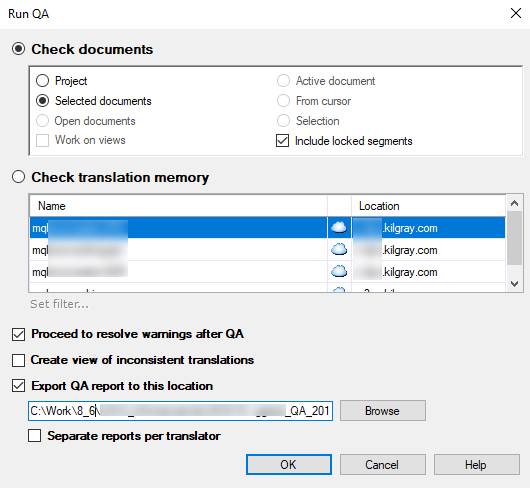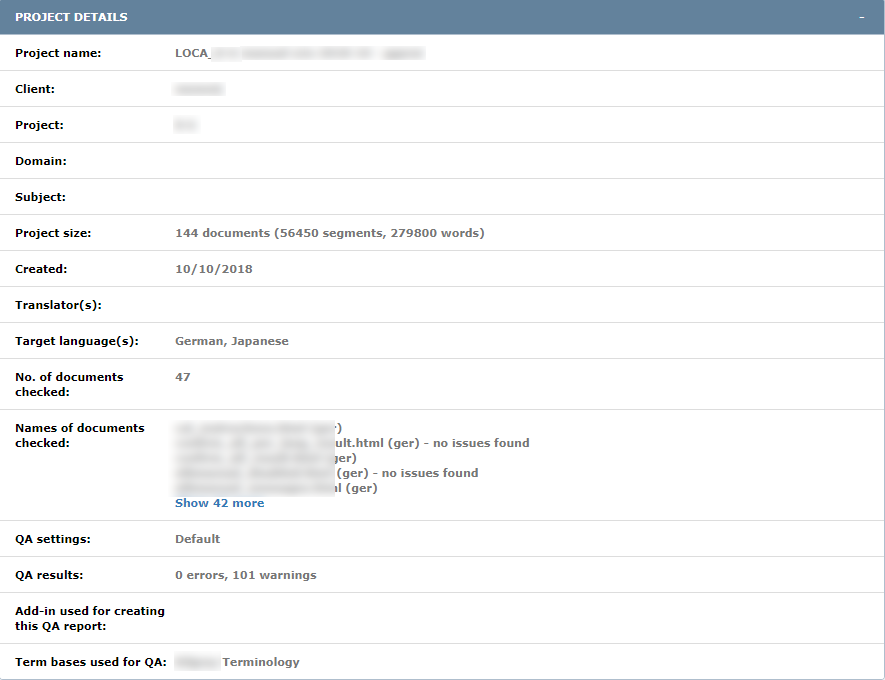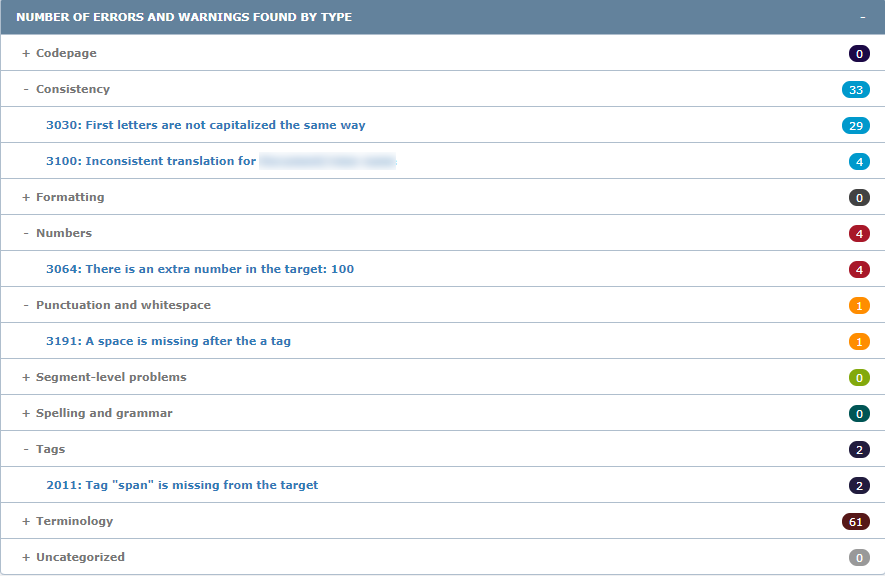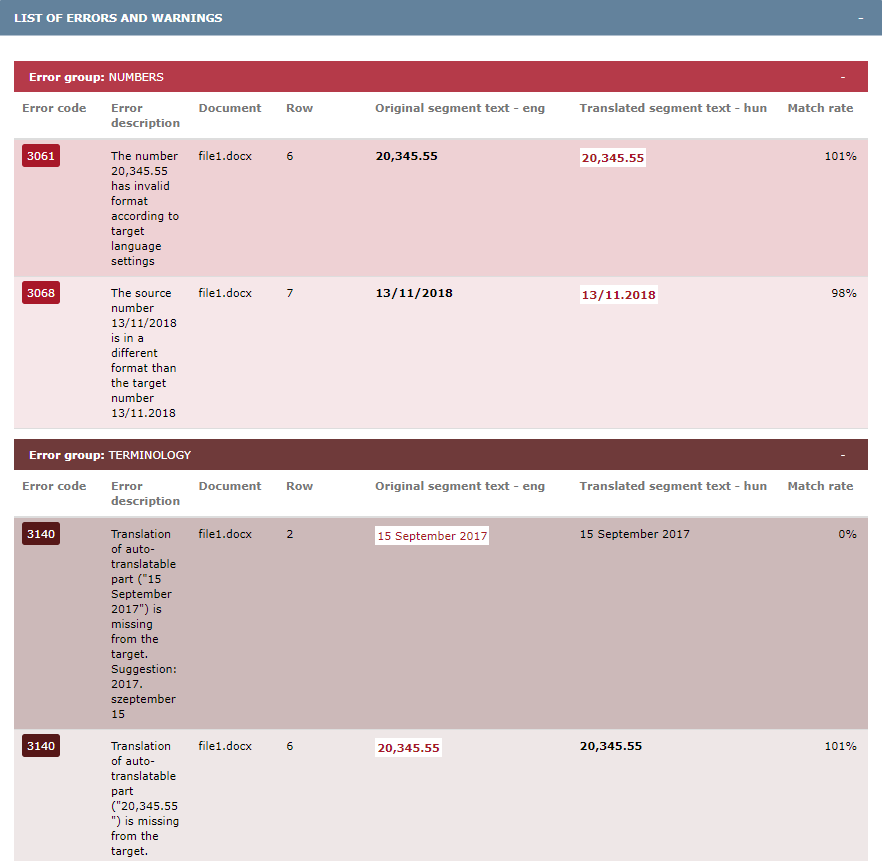Run QA
Normally, memoQ runs quality checks on a document as you translate it.
However, you may need to check different things - or you need to check the consistency on the segment level, which is not done automatically.
If you want to run different checks than those in your project, or you want to check for consistency, use the Run QA command.
If you need to run different checks: Before you run QA, make sure you set up the new QA options in Project home.
How to get here
- Open a project. You may open a document or two, but this is not necessary.
- On the Review ribbon, click Quality Assurance.
The Run QA window opens.

What can you do?
Click the Check documents radio button.
Choose the documents or segments that memoQ must check: Choose a scope.
A scope tells memoQ which documents to look at. You have the following options - choose one radio button:
- Project: memoQ checks all segments in all documents of the current project. If the project has two or more target languages, memoQ will check segments in every target language.
- Active document: memoQ checks all segments in the active document. The active document is the one you are looking at in the translation editor. You can choose this only if you are working on a document in the translation editor.
- Selected documents: memoQ checks all segments in the selected documents. You can choose this only if you select several documents in Translations under Project home. It doesn't work when the translation editor is in the front.
- From cursor: memoQ checks segments below the current position in the active document. The active document is the one you are looking at in the translation editor. You can choose this only if you are working on a document in the translation editor.
- Open documents: memoQ checks all segments in every document that is open in a translation editor tab.
- Selection: memoQ checks the selected segments in the active document. The active document is the one you are looking at in the translation editor. You can choose this only if you are working on a document in the translation editor.
- Work on views check box: Check this to make memoQ go through segments in the views in the current project. You can choose this only if there is at least one view in the project.
To check segments in just one target language: Before opening the Run QA window, choose a language on the Translations pane of Project home. Select all documents, then open Run QA, and choose Selected documents.
Click the Check translation memory radio button.
You can check one of the translation memories in the project. Select the translation memory in the list.
To check a translation memory: You need to open a project that uses it.
Previous errors and warnings will be gone: When you run QA this way, it will erase any previous warnings and errors from the segments that are checked.
Then, decide what happens after the QA checks are run:
- To review the errors and warnings in the Resolve errors and warnings tab, immediately after running the checks: Check the Proceed to resolve warnings after QA check box.
- To look at the inconsistent translations in the translation editor: Check the Create view of inconsistent translations check box.
- Check the Export QA report to this location check box. Find a folder and a name for the report in the box below the check box.
- Normally, memoQ will save the report in your Documents folder. The file will have the name of the project and the date of the QA check. To change this, click Browse. Choose another folder and another name for the file.
Project managers can get a separate report for each translator: You will probably run QA on the work of several translators at once. memoQ can save a separate report for each translator: You can send these reports directly to the translators. They will not see each other's QA reports. To do this, check the Separate reports per translator check box. memoQ will create several files.
Use a web browser to view the report. memoQ saves a HTML file. The file will be large because it is intelligent:
- The Project details section shows information about the project, the checked documents, and the term bases and QA settings used when creating the report:

- The Number of errors and warnings found by type section shows issues grouped by category:

Click the + or - sign to open or close a category. Click an issue type to jump to that category in the List of errors and warnings section. - Filter the issue list in the Filters section:

Click into the fields to see your options. Choose them as needed. When you change something here, the List of errors and warnings section changes accordingly. To change your selection in one field to the opposite: click Invert selection for that field. - See the issues in the List of errors and warnings section:

When you finish
To run the QA checks, and then open the Resolve errors and warnings tab, or open the translation editor, or return to Project home: Click OK.
To return to Project home or to the translation editor, without running the QA checks: Click Cancel.
In the translation editor, there will be a lightning sign in every segment where the QA checks found at least one issue.
Warning may disappear when you confirm a segment: When you confirm a segment, QA will check the segment again. But this time only 'quick' checks are run, consistency checks are not. The warning sign may disappear even if you do not change the segment or the QA settings profile.